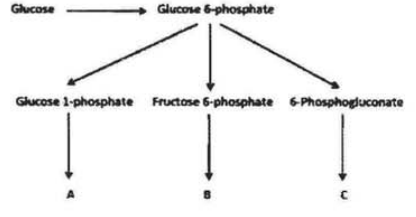 Multiple Choice Questions
Multiple Choice QuestionsHaemoglobin has characteristic circular dichroism (CD) peaks C in the far-UV, near UV and Soret regions. contribution to near-UV CD comes entirely from
aromatic amino acid residues
heme groups
heme and aromatic amino acid residues
peptide bond and aromatic amino acid residues
Tryptic digest of a heptapeptide (built from 3 lysine (K), 2 alanine (A), 1 tyrosine (Y), and 1 phenylalanine (F)) yielded tri and tetrapeptide. Which of the following is the correct sequence of the heptapeptide?
KAYAKFK
YKAAFKK
KYKAAKF
KYAAKFK
100 mL of 0.1 M sodium acetate solution has a pH of 8.90. To this solution 1000μl of 1 M acetic acid (pKa = 4.76) of pH 2.80 is added. The pH of this mixture will be:
8.90
4.76
2.80
5.76
What are A, B, and C in the following reactions?

Pyruvate, ribose 5-phosphate, glycogen
Ribose 5-phosphate, glycogen, pyruvate
Glycogen, pyruvate, ribose 5-phosphate
Glycogen, citrate, ribose 5-phosphate
Michaelis-Menten enzyme kinetics for simple reaction involving an enzyme (E) and substrate (S) is given by the scheme:
E + S E S E + P
The description of Km, kcat, and their relationship is provided in the following statements.
A. Km represents the association constant of the ES complex.
B. Km represents the dissociation constant of the ES complex.
C. kcat is the rate constant for the chemical conversion of the ES complex to substrate-bound enzyme and product.
D. kcat/ Km is a rate constant that refers to the properties and reactions of the free enzyme and free substrate.
Which of the combinations of the above statements is true?
A and C
B and D
A and D
B and C
A 26-residue peptide composed of alanine and leucine shows a circular dichroism (CD) spectrum characteristic of α-helix at 50°C in 5 mM phosphate buffer at pH 7.4. Deconvolution of the spectrum indicates 60% α-helical and 40% random conformation. When the peptide solution is cooled gradually to 25°C, and the CD spectra are recorded at different temperatures, the most likely observation will be that
the % helical content will decrease and % random conformation will increase
the % helical content will increase and % random conformation will decrease
there will be transition from α-helix to β-sheet
there will be transition from α-helix to β-hairpin
It has been observed that for the DNA double helix melting, the value of H (enthalpy change of denaturation) are 80 and 90 kcal/ mole at 70° and 80°C, respectively. Assuming that Cp (constant-pressure heat capacity change) is independent of temperature, estimate H associated with the denaturation of DNA at 37°C. This estimated value of H (kcal/ mole) is
27
37
47
57
The electrospray ionization spectrum of a highly purified protein shows multiple closely spaced peaks. This most likely arises due to
degradation of the protein during recording of the spectrum.
the presence of multiple conformations.
multiple charged species of the protein.
extensive aggregation of the protein.
The average energy absorbed by 10 gm of tissue from 32P radiation is 14.9 Jkg-1. The average dose in rads is
1490
1.49
14900
149
